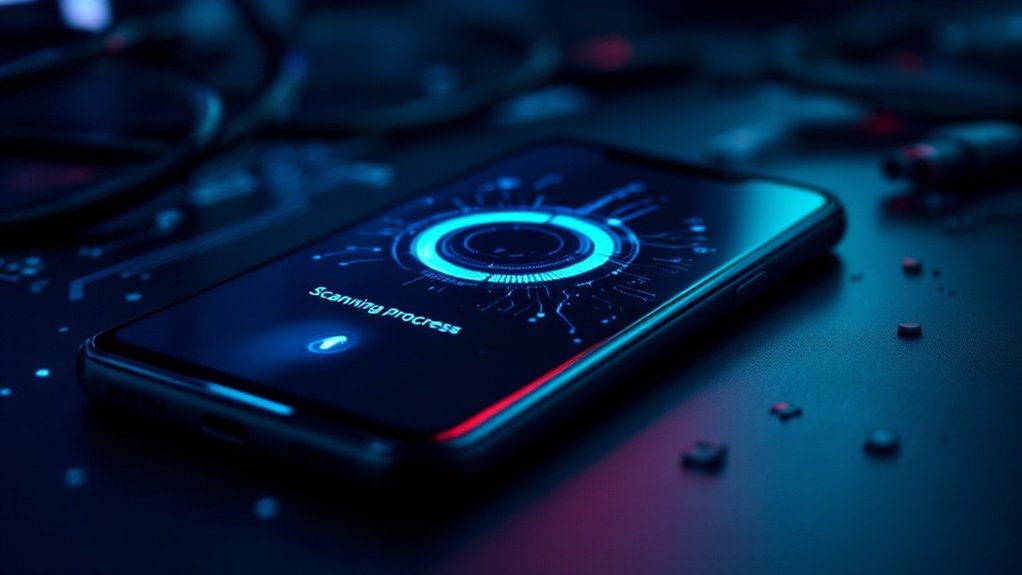Android users can detect spyware through several key indicators and active monitoring steps. Unusual battery drain, device overheating, increased data usage, and unexpected system behaviors often signal spyware presence. Users should regularly scan devices using Google Play Protect, monitor app permissions, and check for unauthorized background processes. Anti-malware applications and systematic security checks provide additional protection, whereas maintaining updated software helps prevent infections. Further investigation reveals extensive detection and prevention strategies.

With the rising frequency of mobile security threats, detecting spyware on Android devices has become increasingly important for protecting personal data and privacy. Users should remain vigilant for common indicators of spyware infection, including unusual battery drain, device overheating, increased data usage, and unexpected system behavior such as applications launching autonomously. These annoying pop-up advertisements often indicate the presence of adware-based spyware infections.
Protecting Android devices from spyware requires constant awareness of suspicious signs like battery drain, overheating, and unusual app behavior.
These warning signs, although not definitively confirming the presence of malicious software, warrant immediate investigation through systematic detection methods. The exploitation of unsecure public Wi-Fi often serves as a gateway for spyware installation on Android devices.
Android users can initiate their spyware detection process by utilizing Google Play Store‘s built-in security features, particularly the Play Protect function. This native tool scans installed applications for potential threats and provides detailed reports of any suspicious findings. Following Apple’s example, maintaining regular software updates is crucial for protecting against emerging security threats.
In addition, specialized third-party antivirus and anti-malware applications offer thorough device scanning capabilities, employing both signature-based and heuristic detection methods to identify potential threats.
Device settings and permissions require careful examination, as spyware often relies on heightened access rights to function effectively. Users should review and disable the “Allow unknown sources” option, preventing the installation of applications from outside the Google Play Store.
Moreover, examining individual app permissions helps identify suspicious access requests that could indicate the presence of monitoring software.
Regular device performance monitoring serves as a vital detection strategy, with users tracking battery consumption patterns, overall system responsiveness, and network activity levels.
Unusual sounds during phone calls or unexpected background processes may signal the presence of surveillance software. A thorough review of installed applications, focusing on those with generic names or vague purposes, can reveal potentially malicious software.
Preventive measures remain significant in maintaining device security, with regular software updates and careful app installation practices forming the foundation of effective spyware prevention.
Users should exclusively download applications from the official Google Play Store, exercise caution when clicking links from unknown sources, and implement strong authentication measures, including unique passwords and two-factor verification, to minimize the risk of spyware infection.
Frequently Asked Questions
Can Spyware Access My Android Device if It’s Turned Off?
Spyware typically cannot access or monitor an Android device when it is completely powered off, as the operating system and hardware components are not functioning.
Nevertheless, advanced firmware-level malware could potentially survive power cycles, and the device remains vulnerable to physical tampering during powered down states.
For maximum security, experts recommend removing the battery when possible, enabling full-disk encryption, and securing the SIM card with a PIN code.
Will a Factory Reset Remove All Types of Spyware?
A factory reset effectively removes most common types of spyware and malware from Android devices, but it cannot guarantee complete elimination of all sophisticated threats.
As the process wipes user data and returns the device to its original state, certain advanced malware can persist in the system partition or firmware level.
Security experts recommend implementing additional post-reset measures, including immediate software updates, password changes, and avoiding potentially compromised backup data restoration.
Can Someone Install Spyware on My Phone Remotely?
Yes, spyware can be installed remotely on Android devices through various methods, including malicious links, compromised websites, and social engineering tactics.
Cybercriminals commonly exploit unpatched vulnerabilities, use fake system updates, or utilize remote management tools to gain unauthorized access.
Although some sophisticated spyware requires physical access initially, many variants can be deployed remotely through phishing attempts, infected messaging apps, or by compromising the user’s Google account credentials.
How Often Should I Scan My Android Device for Spyware?
Security experts recommend scanning Android devices for spyware weekly as a baseline practice, with increased frequency for high-risk users.
Business professionals should perform biweekly scans, whereas average users maintaining good security habits can opt for monthly checks.
Additional scans should be conducted after installing new applications, clicking suspicious links, or noticing unusual device behavior.
Risk factors, including online activities and recent security incidents, may necessitate more frequent monitoring.
Does Using a VPN Protect My Android Device From Spyware?
A VPN provides partial protection against spyware by encrypting internet traffic and masking IP addresses, but cannot offer complete security.
As VPNs effectively prevent network-based surveillance and block malicious websites, they remain ineffective against locally installed spyware or malware already present on the device.
For thorough protection, VPNs should be combined with regular antivirus scans, careful app permission management, and consistent system updates.









